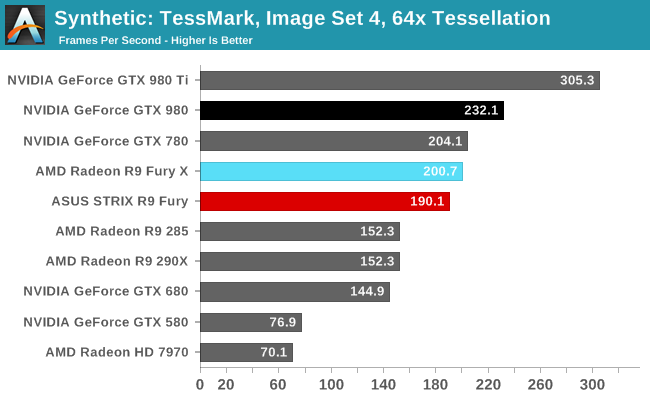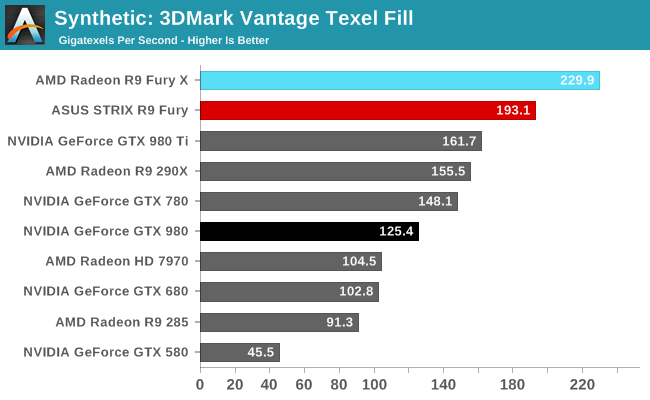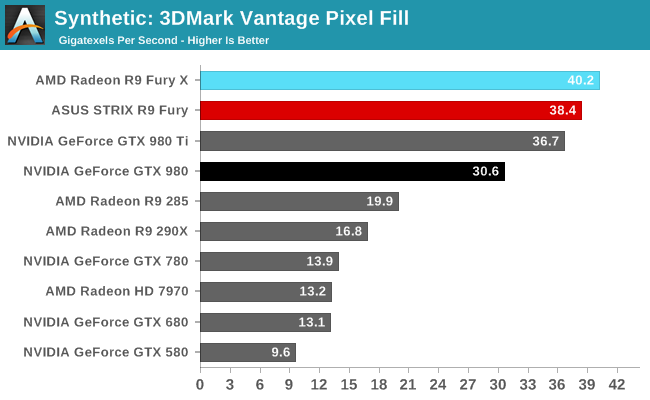The AMD Radeon R9 Fury Review, Feat. Sapphire & ASUS
by Ryan Smith on July 10, 2015 9:00 AM ESTSynthetics
As always we’ll also take a quick look at synthetic performance. Since R9 Fury is a cut-down and lower clocked Fiji part, what we’re expecting here is a significant shader/texture hit, with a much smaller hit to tessellation and pixel throughput.

TessMark scores more or less perfectly scale with clockspeed in this case. The R9 Fury is almost precisely 5% behind the R9 Fury X.


As for 3DMark Vantage, the performance hits are in-line with expectations. The R9 Fury takes a pretty significant hit to texturing performance due to the combination of lost texture units and the clockspeed reduction, while pixel throughput trails by just under 5%. This indicates that at least for the purposes of the 3DMark test, the R9 Fury series is ROP bottlenecked rather than memory bandwidth bottlenecked, a consequence of AMD’s excellent delta color compression.










288 Comments
View All Comments
SolMiester - Saturday, July 11, 2015 - link
WOW, so much fail from AMD...might as well kiss their ass goodbye!Pimping the Fury at 4k, when really even the 980Ti is borderline on occasion, and releasing a card with no OC headroom at the same price as its competitor!
ES_Revenge - Saturday, July 11, 2015 - link
I didn't have too high hopes for the "regular" Fury [Pro] after the disappointing Fury X. However I have to say...this thing makes the Fury X look bad, plain and simple. With a pretty significant cut-down (numerically) in SPs and 32 fewer TMUs, you'd expect this thing to be more of a yawn. Instead it gives very near to Fury X performance and still faster than a GTX 980.The only problem with it is price. At $550 it still costs more than a GTX 980 and Fury has less OC potential. And at only $100 less than Fury X it's not really much of a deal considering the AIO/CLC with that is probably worth $60-80. So really you're only paying $30 or so for the performance increase of Fury X (which isn't that much but it's still faster). What I suggest AMD "needs to do" is price this thing near to where they have the 390X priced. Fury Pro at ~$400 price will pull sales from Nvidia's 980 so fast it's not funny. Accordingly the 390X should be priced lower as well.
But I guess AMD can't really afford to undercut Nvidia at the moment so they're screwed either way. Price is high, people aren't going to bother; lower the price and people will buy but then maybe they're just losing money.
But imagine buying one of these at $400ish, strapping on an Asetek AIO/CLC you might have lying around (perhaps with a Kraken bracket), and you have a tiny little card* with a LOT of GPU power and nice low temps, with performance like a Fury X. Well one can dream, right? lol
*What I don't understand is why Asus did a custom PCB to make the thing *longer*??? One of the coolest things about Fury is how small the card is. They just went and ruined that--they took it and turned it back into a 290X, the clowns. While the Sapphire one still straps on an insanely large cooler, at least if you remove it you're still left with the as-intended short card.
FlushedBubblyJock - Thursday, July 16, 2015 - link
can you even believe the 390x is at $429 and $469 and $479 ... the rebrand over 2.5 years old or so... i mean AMD has GONE NUTS.akamateau - Sunday, July 12, 2015 - link
@Ryan SmithHmmm.
You ran a whole suite of synthetic Benchmarks yet you completely ignored DX12 Starswarm and 3dMarks API Overhead test.
The question that I have is why did you omit DX12 benchmarks?
Starswarm is NOW COMPLETE AND MATURE.
It is also NOT synthetic but rather a full length game simulation; but you know this.
3dMark is synthetic but it is THE prime indicator of the CPU to GPU data pipeline performance.
They are also all we have right now to adequately judge the value of a $549 dollar AMD GPU vs a $649 nVidia GPU for new games coming up.
Since better than 50% of games released this Christmas will be DX12 don't you think that consumers have a right to know how well a high performance API will work with a dGPU card designed to run on both Mantle and DX12?
AMD did not position Fiji for DX11. This card IS designed for DX12 and Mantle.
So show us how well it does.
Ryan Smith - Monday, July 13, 2015 - link
The Star Swarm benchmark is, by design, a proof of concept. It is meant to showcase the benefits of DX12/Mantle as it applies to draw calls, not to compare the gaming performance of video cards.Furthermore the latest version is running a very old version of the engine that has seen many changes. We will not be able to include any Oxide engine games until Ashes of the Singularity (which looks really good, by the way) is out of beta.
Finally, the 3DMark API Overhead test is not supposed to be used to compare video cards from different vendors. From the technical guide: "The API Overhead feature test is not a general-purpose GPU benchmark, and it should not be used to compare graphics cards from different vendors."
FlushedBubblyJock - Thursday, July 16, 2015 - link
" Since better than 50% of games released this Christmas will be DX12 "I'LL BET YOU A GRAND THAT DOES NOT HAPPEN.
It's always the amd fanboy future, with the svengali ESP blabbed in for full on PR BS...
akamateau - Sunday, July 12, 2015 - link
@Ryan SmithDo you also realise that Fiji completely outclasses Maxwell and Tesla as well?
Gaming is a sideshow. AMD is positioning Fury x to sell for $350+ as a single unit silicon for HPC. With HBM on the package!!!
HPGPU computing is now up for grabs. Compaing the Fiji PACKAGE to the Maxwell or Tesla PACKAGE has AMD thoroughly outclassing the Professional Workstation and HPC silicon.
HBM stacked memory can be configured as cache and still feed GDDR5 RAM for multiple monitors.
AMD has several patents for just that while using HBM stacked memory.
I think that AMD is quietly positioning Fiji and Greenland next for High Performance Computing.
Fury X2 with 17 Tflps of single precision and almost 8Tflops dual precison is going to change the cluster server market.
Of course Fury X2 will rock this Christmas.
What will be the release price? I think less than $999!!!
AMD has made a habit of being the grinch that stole nVidias Christmas.
Ryan Smith - Monday, July 13, 2015 - link
Note that Fiji is not expected to appear in any HPC systems. It has no ECC, minimal speed FP64, and only 4GB of VRAM. HPC users are generally after processors with large amounts of memory and ECC, and frequently FP64 as well.AMD's HPC product for this cycle is the FirePro S9170, a 32GB Hawaii card: http://www.amd.com/en-us/products/graphics/server/...
FlushedBubblyJock - Thursday, July 16, 2015 - link
ROFLMAO delusion after delusion...loguerto - Sunday, July 12, 2015 - link
Looking at what happened with the old generation AMD and nvidia gpus, i wouldn't be surprised if after a few driver updates the fiji will be so ahead of maxwell. AMD always improved it's old architectures with software updates while nvidia quite never did that, actually they downgrade their old gpus so that they can sell their next overpriced SoC.